Zhenyu Li
Shandong University
MyGO: Make your Goals Obvious, Avoiding Semantic Confusion in Prostate Cancer Lesion Region Segmentation
Jul 23, 2025Abstract:Early diagnosis and accurate identification of lesion location and progression in prostate cancer (PCa) are critical for assisting clinicians in formulating effective treatment strategies. However, due to the high semantic homogeneity between lesion and non-lesion areas, existing medical image segmentation methods often struggle to accurately comprehend lesion semantics, resulting in the problem of semantic confusion. To address this challenge, we propose a novel Pixel Anchor Module, which guides the model to discover a sparse set of feature anchors that serve to capture and interpret global contextual information. This mechanism enhances the model's nonlinear representation capacity and improves segmentation accuracy within lesion regions. Moreover, we design a self-attention-based Top_k selection strategy to further refine the identification of these feature anchors, and incorporate a focal loss function to mitigate class imbalance, thereby facilitating more precise semantic interpretation across diverse regions. Our method achieves state-of-the-art performance on the PI-CAI dataset, demonstrating 69.73% IoU and 74.32% Dice scores, and significantly improving prostate cancer lesion detection.
Kwai Keye-VL Technical Report
Jul 02, 2025Abstract:While Multimodal Large Language Models (MLLMs) demonstrate remarkable capabilities on static images, they often fall short in comprehending dynamic, information-dense short-form videos, a dominant medium in today's digital landscape. To bridge this gap, we introduce \textbf{Kwai Keye-VL}, an 8-billion-parameter multimodal foundation model engineered for leading-edge performance in short-video understanding while maintaining robust general-purpose vision-language abilities. The development of Keye-VL rests on two core pillars: a massive, high-quality dataset exceeding 600 billion tokens with a strong emphasis on video, and an innovative training recipe. This recipe features a four-stage pre-training process for solid vision-language alignment, followed by a meticulous two-phase post-training process. The first post-training stage enhances foundational capabilities like instruction following, while the second phase focuses on stimulating advanced reasoning. In this second phase, a key innovation is our five-mode ``cold-start'' data mixture, which includes ``thinking'', ``non-thinking'', ``auto-think'', ``think with image'', and high-quality video data. This mixture teaches the model to decide when and how to reason. Subsequent reinforcement learning (RL) and alignment steps further enhance these reasoning capabilities and correct abnormal model behaviors, such as repetitive outputs. To validate our approach, we conduct extensive evaluations, showing that Keye-VL achieves state-of-the-art results on public video benchmarks and remains highly competitive on general image-based tasks (Figure 1). Furthermore, we develop and release the \textbf{KC-MMBench}, a new benchmark tailored for real-world short-video scenarios, where Keye-VL shows a significant advantage.
RIS-Assisted Survivable Fronthaul Design in Cell-Free Massive MIMO System
May 25, 2025Abstract:This paper investigates the application of reconfigurable intelligent surfaces (RISs) to improve fronthaul link survivability in cell-free massive MIMO (CF mMIMO) systems. To enhance the fronthaul survivability, two complementary mechanisms are considered. Firstly, RIS is set to provide reliable line-of-sight (LOS) connectivity and enhance the mmWave backup link. Secondly, a resource-sharing scheme that leverages redundant cable capacity through neighboring master access points (APs) to guarantee availability is considered. We formulate the redundant capacity minimization problem as a RIS-assisted multi-user MIMO rate control optimization problem, developing a novel solution that combines a modified weighted minimum mean square error (WMMSE) algorithm for precoding design with Riemannian gradient descent for RIS phase shift optimization. Our numerical evaluations show that RIS reduces the required redundant capacity by 65.6% compared to the no RIS case to reach a 99% survivability. The results show that the most substantial gains of RIS occur during complete outages of the direct disconnected master AP-CPU channel. These results demonstrate RIS's potential to significantly enhance fronthaul reliability while minimizing infrastructure costs in next-generation wireless networks.
Place Recognition: A Comprehensive Review, Current Challenges and Future Directions
May 20, 2025Abstract:Place recognition is a cornerstone of vehicle navigation and mapping, which is pivotal in enabling systems to determine whether a location has been previously visited. This capability is critical for tasks such as loop closure in Simultaneous Localization and Mapping (SLAM) and long-term navigation under varying environmental conditions. In this survey, we comprehensively review recent advancements in place recognition, emphasizing three representative methodological paradigms: Convolutional Neural Network (CNN)-based approaches, Transformer-based frameworks, and cross-modal strategies. We begin by elucidating the significance of place recognition within the broader context of autonomous systems. Subsequently, we trace the evolution of CNN-based methods, highlighting their contributions to robust visual descriptor learning and scalability in large-scale environments. We then examine the emerging class of Transformer-based models, which leverage self-attention mechanisms to capture global dependencies and offer improved generalization across diverse scenes. Furthermore, we discuss cross-modal approaches that integrate heterogeneous data sources such as Lidar, vision, and text description, thereby enhancing resilience to viewpoint, illumination, and seasonal variations. We also summarize standard datasets and evaluation metrics widely adopted in the literature. Finally, we identify current research challenges and outline prospective directions, including domain adaptation, real-time performance, and lifelong learning, to inspire future advancements in this domain. The unified framework of leading-edge place recognition methods, i.e., code library, and the results of their experimental evaluations are available at https://github.com/CV4RA/SOTA-Place-Recognitioner.
LaRI: Layered Ray Intersections for Single-view 3D Geometric Reasoning
Apr 25, 2025

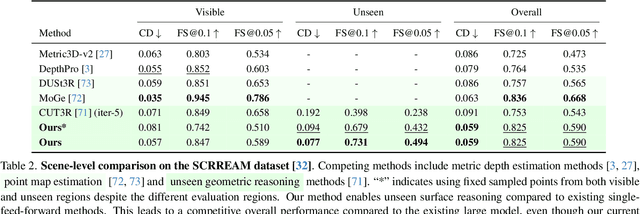

Abstract:We present layered ray intersections (LaRI), a new method for unseen geometry reasoning from a single image. Unlike conventional depth estimation that is limited to the visible surface, LaRI models multiple surfaces intersected by the camera rays using layered point maps. Benefiting from the compact and layered representation, LaRI enables complete, efficient, and view-aligned geometric reasoning to unify object- and scene-level tasks. We further propose to predict the ray stopping index, which identifies valid intersecting pixels and layers from LaRI's output. We build a complete training data generation pipeline for synthetic and real-world data, including 3D objects and scenes, with necessary data cleaning steps and coordination between rendering engines. As a generic method, LaRI's performance is validated in two scenarios: It yields comparable object-level results to the recent large generative model using 4% of its training data and 17% of its parameters. Meanwhile, it achieves scene-level occluded geometry reasoning in only one feed-forward.
COMM:Concentrated Margin Maximization for Robust Document-Level Relation Extraction
Mar 18, 2025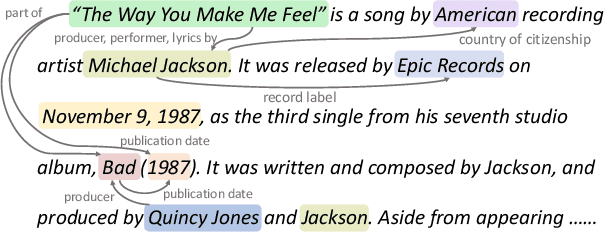
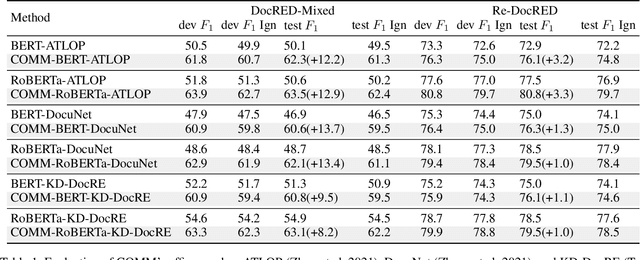
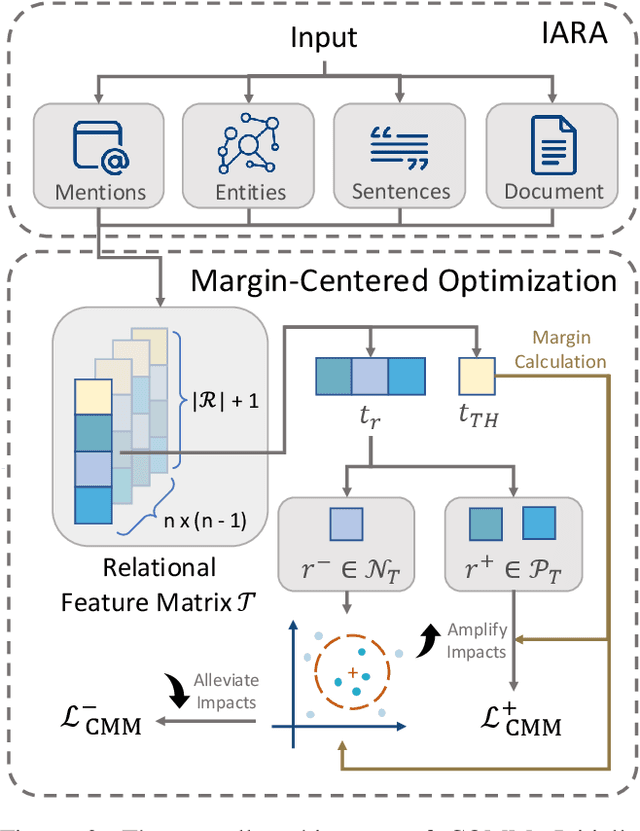
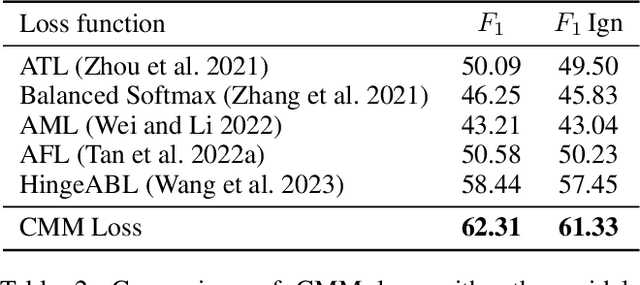
Abstract:Document-level relation extraction (DocRE) is the process of identifying and extracting relations between entities that span multiple sentences within a document. Due to its realistic settings, DocRE has garnered increasing research attention in recent years. Previous research has mostly focused on developing sophisticated encoding models to better capture the intricate patterns between entity pairs. While these advancements are undoubtedly crucial, an even more foundational challenge lies in the data itself. The complexity inherent in DocRE makes the labeling process prone to errors, compounded by the extreme sparsity of positive relation samples, which is driven by both the limited availability of positive instances and the broad diversity of positive relation types. These factors can lead to biased optimization processes, further complicating the task of accurate relation extraction. Recognizing these challenges, we have developed a robust framework called \textit{\textbf{COMM}} to better solve DocRE. \textit{\textbf{COMM}} operates by initially employing an instance-aware reasoning method to dynamically capture pertinent information of entity pairs within the document and extract relational features. Following this, \textit{\textbf{COMM}} takes into account the distribution of relations and the difficulty of samples to dynamically adjust the margins between prediction logits and the decision threshold, a process we call Concentrated Margin Maximization. In this way, \textit{\textbf{COMM}} not only enhances the extraction of relevant relational features but also boosts DocRE performance by addressing the specific challenges posed by the data. Extensive experiments and analysis demonstrate the versatility and effectiveness of \textit{\textbf{COMM}}, especially its robustness when trained on low-quality data (achieves \textgreater 10\% performance gains).
XIFBench: Evaluating Large Language Models on Multilingual Instruction Following
Mar 10, 2025Abstract:Large Language Models (LLMs) have demonstrated remarkable instruction-following capabilities across various applications. However, their performance in multilingual settings remains poorly understood, as existing evaluations lack fine-grained constraint analysis. We introduce XIFBench, a comprehensive constraint-based benchmark for assessing multilingual instruction-following abilities of LLMs, featuring a novel taxonomy of five constraint categories and 465 parallel instructions across six languages spanning different resource levels. To ensure consistent cross-lingual evaluation, we develop a requirement-based protocol that leverages English requirements as semantic anchors. These requirements are then used to validate the translations across languages. Extensive experiments with various LLMs reveal notable variations in instruction-following performance across resource levels, identifying key influencing factors such as constraint categories, instruction complexity, and cultural specificity.
Bridging Text and Vision: A Multi-View Text-Vision Registration Approach for Cross-Modal Place Recognition
Feb 20, 2025



Abstract:Mobile robots necessitate advanced natural language understanding capabilities to accurately identify locations and perform tasks such as package delivery. However, traditional visual place recognition (VPR) methods rely solely on single-view visual information and cannot interpret human language descriptions. To overcome this challenge, we bridge text and vision by proposing a multiview (360{\deg} views of the surroundings) text-vision registration approach called Text4VPR for place recognition task, which is the first method that exclusively utilizes textual descriptions to match a database of images. Text4VPR employs the frozen T5 language model to extract global textual embeddings. Additionally, it utilizes the Sinkhorn algorithm with temperature coefficient to assign local tokens to their respective clusters, thereby aggregating visual descriptors from images. During the training stage, Text4VPR emphasizes the alignment between individual text-image pairs for precise textual description. In the inference stage, Text4VPR uses the Cascaded Cross-Attention Cosine Alignment (CCCA) to address the internal mismatch between text and image groups. Subsequently, Text4VPR performs precisely place match based on the descriptions of text-image groups. On Street360Loc, the first text to image VPR dataset we created, Text4VPR builds a robust baseline, achieving a leading top-1 accuracy of 57% and a leading top-10 accuracy of 92% within a 5-meter radius on the test set, which indicates that localization from textual descriptions to images is not only feasible but also holds significant potential for further advancement, as shown in Figure 1.
DoubleDiffusion: Combining Heat Diffusion with Denoising Diffusion for Generative Learning on 3D Meshes
Jan 06, 2025
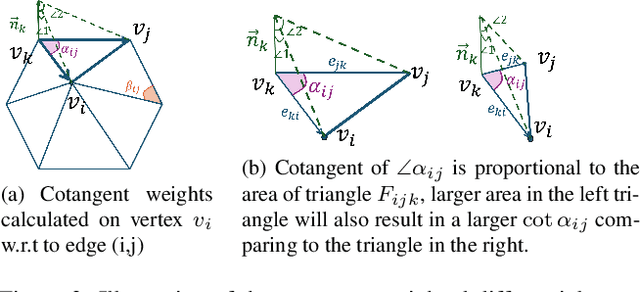

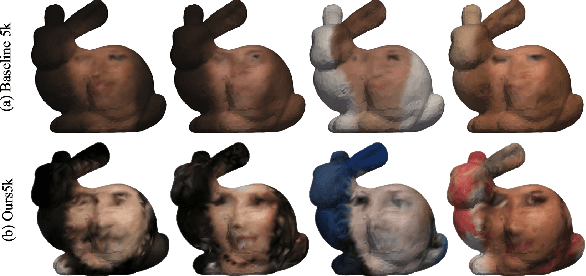
Abstract:This paper proposes DoubleDiffusion, a novel framework that combines heat dissipation diffusion and denoising diffusion for direct generative learning on 3D mesh surfaces. Our approach addresses the challenges of generating continuous signal distributions residing on a curve manifold surface. Unlike previous methods that rely on unrolling 3D meshes into 2D or adopting field representations, DoubleDiffusion leverages the Laplacian-Beltrami operator to process features respecting the mesh structure. This combination enables effective geometry-aware signal diffusion across the underlying geometry. As shown in Fig.~\ref{fig:teaser}, we demonstrate that DoubleDiffusion has the ability to generate RGB signal distributions on complex 3D mesh surfaces and achieves per-category shape-conditioned texture generation across different shape geometry. Our work contributes a new direction in diffusion-based generative modeling on 3D surfaces, with potential applications in the field of 3D asset generation.
PatchRefiner V2: Fast and Lightweight Real-Domain High-Resolution Metric Depth Estimation
Jan 02, 2025Abstract:While current high-resolution depth estimation methods achieve strong results, they often suffer from computational inefficiencies due to reliance on heavyweight models and multiple inference steps, increasing inference time. To address this, we introduce PatchRefiner V2 (PRV2), which replaces heavy refiner models with lightweight encoders. This reduces model size and inference time but introduces noisy features. To overcome this, we propose a Coarse-to-Fine (C2F) module with a Guided Denoising Unit for refining and denoising the refiner features and a Noisy Pretraining strategy to pretrain the refiner branch to fully exploit the potential of the lightweight refiner branch. Additionally, we introduce a Scale-and-Shift Invariant Gradient Matching (SSIGM) loss to enhance synthetic-to-real domain transfer. PRV2 outperforms state-of-the-art depth estimation methods on UnrealStereo4K in both accuracy and speed, using fewer parameters and faster inference. It also shows improved depth boundary delineation on real-world datasets like CityScape, ScanNet++, and KITTI, demonstrating its versatility across domains.
 Add to Chrome
Add to Chrome Add to Firefox
Add to Firefox Add to Edge
Add to Edge